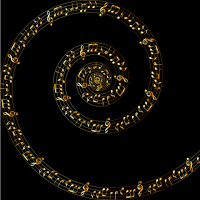They were published in September 1747.
The Ricercar a 6, a six-voice fugue which is regarded
as the high point of the entire work, was put forward by the musicologist
Charles Rosen as the most significant piano composition in history (partly because
it is one of the first).
This ricercar is also occasionally called the Prussian
Fugue, a name used by Bach himself.
The collection has its roots
in a meeting between Bach and Frederick II on May 7, 1747.
The meeting, taking place at
the king's residence in Potsdam, came about because Bach's son Carl Philipp
Emanuel was employed there as court musician.
Frederick wanted to show the
elder Bach a novelty, the fortepiano, which had been invented some years
earlier.
The king owned several of
the experimental instruments being developed by Gottfried Silbermann.
During his anticipated visit
to Frederick's palace in Potsdam, Bach, who was well known for his skill at
improvising, received from Frederick a long and complex musical theme on which
to improvise a three-voice fugue.
He did so, but Frederick
then challenged him to improvise a six-voice fugue on the same theme.
Bach answered that he would
need to work the score and send it to the king afterwards.
He then returned to Leipzig
to write out the Thema Regium ("theme of the king"):
Four months after the
meeting, Bach published a set of pieces based on this theme which we now know
as The Musical Offering.
Bach inscribed the piece
"Regis Iussu Cantio Et Reliqua Canonica Arte Resoluta" (the theme
given by the king, with additions, resolved in the canonic style), the first
letters of which spell out the word ricercar, a well-known genre of the time.
Structure and instrumentation
In its finished form, The
Musical Offering comprises:
Two Ricercars, written down
on as many staves as there are voices:
a Ricercar a 3 (a
three-voice fugue)
a Ricercar a 6 (a six-voice
fugue)
Ten Canons:
Canones diversi super Thema
Regium:
2 Canons a 2 (the first
representing a notable example of a crab canon or canon cancrizans)
Canon a 2, per motum
contrarium
Canon a 2, per
augmentationem, contrario motu
Canon a 2, per tonos
Canon perpetuus
Fuga canonica in Epidiapente
Canon a 2 "Quaerendo
invenietis"
Canon a 4
Canon perpetuus, contrario
motu
A Sonata sopr'il Soggetto
Reale – a trio sonata featuring the flute, an instrument which Frederick
played, consisting of four movements:
Largo
Allegro
Andante
Allegro
Apart from the trio sonata,
which is written for flute, violin and basso continuo, the pieces have few
indications of which instruments are meant to play them, although there is now
significant support for the idea that they are for solo keyboard, like most of
Bach's other published works.
The ricercars and canons
have been realised in various ways.
The ricercars are more
frequently performed on keyboard than the canons, which are often played by an
ensemble of chamber musicians, with instrumentation comparable to that of the
trio sonata.
As the printed version gives
the impression of being organised for convenient page turning when
sight-playing the score, the order of the pieces intended by Bach (if there was
an intended order) remains uncertain, although it is customary to open the collection
with the Ricercar a 3, and play the trio sonata toward the end.
The Canones super Thema
Regium are also usually played together.
Musical riddles
Some of the canons of The
Musical Offering are represented in the original score by no more than a short
monodic melody of a few measures, with a more or less enigmatic inscription in
Latin above the melody.
These compositions are
called the riddle fugues (or sometimes, more appropriately, the riddle canons).
The performer(s) is/are
supposed to interpret the music as a multi-part piece (a piece with several
intertwining melodies), while solving the "riddle".
Some of these riddles have
been explained to have more than one possible "solution", although
nowadays most printed editions of the score give a single, more or less
"standard" solution of the riddle, so that interpreters can just
play, without having to worry about the Latin, or the riddle.
One of these riddle canons,
"in augmentationem" (i.e. augmentation, the length of the notes gets
longer), is inscribed "Notulis crescentibus crescat Fortuna Regis"
(may the fortunes of the king increase like the length of the notes), while a
modulating canon which ends a tone higher than it starts is inscribed
"Ascendenteque Modulatione ascendat Gloria Regis" (as the modulation
rises, so may the king's glory).
Canon per tonos (endlessly rising canon)
The canon per tonos
(endlessly rising canon) pits a variant of the king's theme against a two-voice
canon at the fifth. However, it modulates and finishes one whole tone higher
than it started out at. It thus has no final cadence.
J. S. Bach - Triosonata in C
minor from the 'Musical Offering', BWV 1079 Nr. 8.webm
Look it up on Wikipedia
Photo: Johann Sebastian Bach, The Musical Offering, BWV 1079. (Canon 1, and 2 violini in unisono) Wikipedia

%20(2).png)


